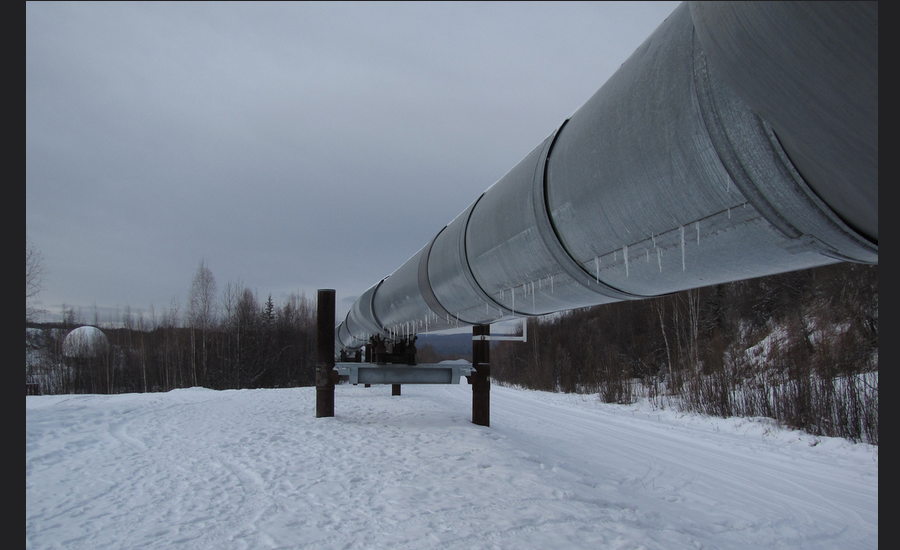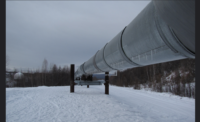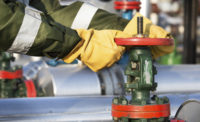The rural plains of North Dakota are lonely and unforgiving. This is the flattened, semi-industrial part of the state, where the infrastructure of oil production—oil and natural gas holding tanks connected to pipelines and nearby pump jacks – is omnipresent.
One project is the Dakota Access Pipeline (DAPL). Construction of the 1,200-mile pipeline began in May of 2016, taking place simultaneously on three sections. It is designed to carry 570,000 barrels of oil a day, more than any other pipeline ever built in North Dakota. It originates in the upper northwest corner of the state, passes through South Dakota, then Iowa, and ends near Patoka, Illinois, where it connects to the Energy Transfer Crude Oil Pipeline (ETCO), which carries the oil onward to Texas and, if completed, via the Bayou Bridge Pipeline to Louisiana. From these Gulf Coast ports, much of the oil will hitch a tanker ride to distant markets overseas, either as crude or after being refined into other products, such as gasoline or ethylene, a petrochemical that is used to make plastics.
On an August day, a piece of farming equipment called a Ripper was restoring the ground above where the pipeline has been laid so that grass can take root and grow there. The machine tears through the earth using metal shanks attached to a horizontal frame via large coiled springs. The springs allow the shanks to rebound, so they don't get stuck on rocks or rough soil. As pipeline jobs go, this is considered one of the least risky. Known as reclamation and restoration, it is the final phase of construction, in which the earth above the pipeline is tilled and reseeded.
But something happened on that August day. According to an OSHA investigation, at some point along the way, the Ripper struck a large rock, locking a spring-loaded shank in the air. The driver got out, and set to work trying to fix it. He appears to have tried using a jack stand as a makeshift pry bar, jamming the long steel rod into the spring above his head. The spring did recompress, according to Indianhead's incident report, sending the shank back down into position, but with such extreme speed and force that the pry bar was launched directly into the top of the worker’s head. Somehow, he managed to climb back into his tractor, take off his shirt, and wrap it around his head before collapsing onto the steering wheel, where he remained—critically injured and alone.
He could have contacted a foreman to request a skilled repair person, but OSHA investigators were told his decision to go it alone with what may have seemed like a minor repair is common practice—most workers know that time is money in the oil patch.
There was no manual for the Ripper in the tractor, which OSHA identified as a violation. But a manual would likely not have done much good. OSHA found that the equipment operator had borrowed the Ripper, and that the machine had been altered. Upon reviewing the case, the Ripper manufacturer reported to OSHA that the alteration (which involved the removal of two shanks) was the likely cause of the locked spring. Preventive maintenance on the borrowed piece of equipment might have alerted the operating company to a potential problem, but when OSHA investigators asked the foreman about this, he chuckled, saying, "We don't really have a program for it."
The injured worker was not discovered until 2 p.m., when a co-worker noticed the tractor idle in the distance. The victim was still conscious and able to answer some basic questions, but in immediate need of medical care.
At approximately 3 p.m., he arrived at the local medical center, and then airlifted 80 miles to a Hospital in Minot. Barely 24 hours after being found, the work died with his parents by his side
The first year that the Bureau of Labor Statistics reported the number of oil and gas pipeline construction workers who died at work was 2003. Since then, their on-the-job fatality rate has averaged 4.3 times more than the national average, reaching highs of approximately seven times greater than the national average in both 2005 and 2009. The number of deaths increased by 60 percent, from 15 in 2003 to 25 in 2009—the year with the most oil and gas pipeline construction worker deaths ever recorded.
These findings are consistent with the oil and gas industry as a whole, which is regularly found to be among the deadliest in the nation. The National Institute for Occupational Safety and Health at the Centers for Disease Control and Prevention began investigating increasing deaths among oil and gas extraction workers in 2005, finding that, in 2014, they suffered a fatality rate nearly seven times greater than that of the average American worker. For the last 10 years, oil and gas extraction workers have had one of the highest fatality rates in the nation, reaching a high of 7.5 times more than the national average in 2012.
Employment in oil and gas extraction nationally has dropped from its modern high of nearly 588,000 people in 2014 to fewer than 380,000 in 2016. Employment in oil and gas pipeline construction is smaller still, though it more than doubled from 2004 to 2017, from 68,300 to 143,800 workers. These jobs collectively are not only deadlier than most, they are also more likely to result in serious injury. Energywire reports that, from January 1st, 2015, to October 31st, 2016, oil and gas pipeline construction workers had some of the highest rates of serious injuries on the job among industries with more than 100,000 employees, and oil and gas extraction workers had the highest.
The number and rate of oil and gas extraction worker deaths actually decreased in 2015 and again in 2016 as production ebbed, but the number of pipeline worker deaths increased. By 2016, the number of pipeline incidents causing fatalities or serious injury (those requiring hospitalization) to workers and the general public reached its highest level since 2009, according to the Pipeline and Hazardous Materials Safety Administration.
In 2017, the AFL-CIO warned in its annual report Death on the Job that escalating fatalities and injuries in the oil and gas sector raise "serious concerns about an industry wrought with dangerous working conditions and largely exempt from protective regulations." For the fourth time in the last five years, the AFL-CIO report named North Dakota the riskiest state in the nation in which to work, with a higher worker death rate than any other.
Rather than hire permanent full-time salaried employees, many companies hire temporary contractors and subcontractors, which then hire temporary workers. According to an analysis by industry advisory group ISN, oil and gas contractors and subcontractors have had higher incident rates resulting in harm to their workers when compared to in-house employees.



